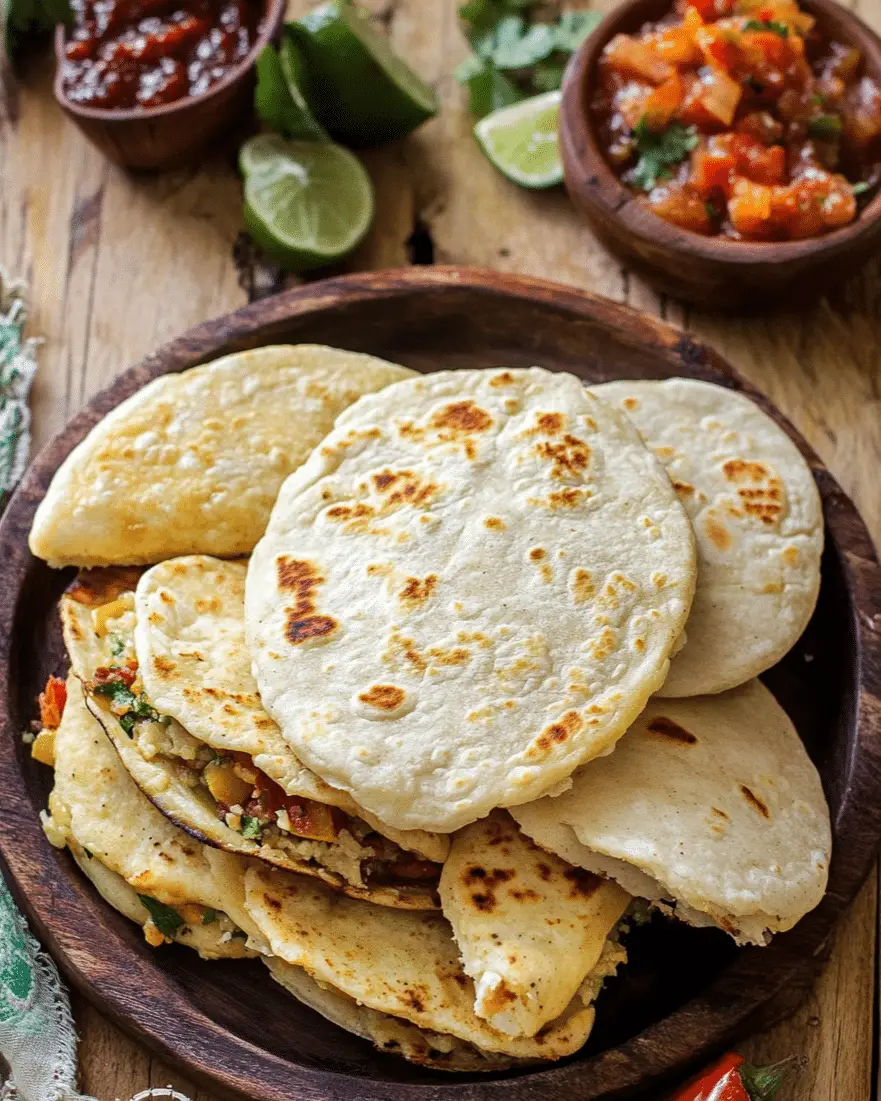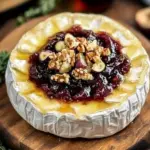Gorditas with Maseca are a beloved staple in traditional Mexican cooking, known for their soft yet slightly crispy texture. These thick corn cakes are made with masa harina (corn flour) and are the perfect canvas for both savory and sweet fillings. From refried beans and crumbled cheese to shredded meats and spicy salsas, their versatility makes them an essential recipe for anyone who loves authentic Mexican flavors.
What makes these gorditas special is their handcrafted nature. Each one is shaped and cooked with care, producing a warm, golden-brown pocket that’s as satisfying to hold as it is to eat. Whether you enjoy them stuffed, topped, or simply plain with a bit of butter, these Maseca gorditas bring the taste of a Mexican street market right to your kitchen. They’re quick to prepare, naturally gluten-free, and a great way to add tradition to any meal.
Full Recipe:
Ingredients:
-
2 cups Maseca corn flour (masa harina)
-
1 ½ cups warm water (plus more if needed)
-
½ teaspoon salt
-
1 tablespoon vegetable oil (plus extra for cooking)
Directions:
-
In a large mixing bowl, combine the Maseca corn flour and salt.
-
Gradually pour in the warm water while mixing with your hands until a soft, pliable dough forms. The dough should feel moist but not sticky. If it’s too dry, add water a tablespoon at a time.
-
Divide the dough into 10 equal portions and roll each into a ball.
-
Flatten each ball gently with your hands or a tortilla press to about ½ inch thick.
-
Heat a large skillet or comal over medium heat and lightly brush with vegetable oil.
-
Cook each gordita for 2–3 minutes per side, until golden spots appear and they puff slightly.
-
Transfer to a plate and let them rest for a minute.
-
Carefully slice open one side to create a pocket, if desired, for stuffing with your favorite fillings.
Prep Time: 10 minutes | Cooking Time: 15 minutes | Total Time: 25 minutes
Kcal: 110 kcal | Servings: 10 gorditas
Gorditas with Maseca – A Traditional Mexican Delight
Few dishes capture the heart of traditional Mexican street food quite like gorditas. These thick, golden corn pockets, made from Maseca (a brand of masa harina), are soft on the inside, slightly crispy on the outside, and endlessly versatile. Whether enjoyed plain, split open and stuffed with savory fillings, or topped with your favorite garnishes, gorditas are a comforting taste of Mexico that’s as much about tradition as it is about flavor.
In Mexican cuisine, masa harina (corn flour) is the cornerstone of countless recipes, from tortillas and tamales to sopes and pupusas. Gorditas stand out because of their pillowy texture and the way they can cradle anything from refried beans to shredded meat or even fresh vegetables. Made from a simple mixture of masa harina, warm water, salt, and a bit of oil, they’re proof that some of the best recipes are also the simplest.
The Meaning Behind Gorditas
The word gordita translates to “little fat one” in Spanish, and it’s an affectionate name referring to their thicker, puffier nature compared to regular corn tortillas. They are not overly greasy or heavy, just pleasantly substantial. When you bite into a freshly cooked gordita, you’re met with a soft, tender interior wrapped in a slightly crisp shell from cooking on a hot skillet or comal.
Gorditas are not just a recipe, they are part of the cultural fabric of Mexico. Found at street food stalls, markets, and home kitchens alike, they’re a food that brings people together. Families often make a large batch for breakfast, lunch, or dinner, filling them with whatever’s on hand. It’s the kind of food that feels familiar and comforting even if it’s your first time trying it.
Why Use Maseca for Gorditas?
While you can make gorditas with any brand of masa harina, Maseca is often the preferred choice for home cooks and street vendors alike. It’s widely available, finely milled, and consistent in quality, which helps create a smooth dough that’s easy to work with. Maseca’s corn flour has the right balance of flavor and texture to produce gorditas that puff slightly, hold their shape, and have that authentic Mexican taste.
The brand also offers gluten-free varieties, making gorditas an excellent choice for those avoiding wheat while still enjoying hearty, satisfying bread-like options. Since masa harina is naturally made from nixtamalized corn (corn treated with lime), it carries a depth of flavor that can’t be matched by regular cornmeal.
The Secret to Perfect Gorditas
The key to achieving the perfect gordita is dough consistency. It should be moist and pliable, not sticky or crumbly. If the dough is too dry, your gorditas will crack; too wet, and they’ll stick to your hands or break apart while cooking. Warm water is essential to help the masa hydrate evenly.
When pressing the dough, aim for about ½ inch thickness, thicker than a tortilla, but not so thick that the inside won’t cook through. Cooking over medium heat allows the outside to crisp slightly while giving the interior time to steam and become tender. You’ll know they’re ready when you see golden-brown spots and the edges begin to firm up.
How Gorditas Are Served
One of the joys of making gorditas is their versatility. You can serve them in several ways:
-
Split and Stuffed: Slice one side open to create a pocket and fill with beans, cheese, shredded chicken, beef, or vegetables.
-
Topped Open-Faced: Treat them like sopes and top with salsa, crumbled cheese, lettuce, and crema.
-
Plain with Butter: Enjoy them warm from the skillet with just a smear of butter for a simple snack.
-
Sweet Variation: For a twist, sprinkle them with cinnamon sugar or fill with sweetened cream.
Gorditas are equally at home as a main dish, a side, or even as a portable street snack.
Traditional and Regional Variations
Across Mexico, gorditas take on different personalities depending on the region:
-
Gorditas de Nata: A sweet, breakfast-style gordita made with cream and flour rather than masa harina.
-
Gorditas de Chicharrón: Masa dough is mixed with bits of crispy pork cracklings before cooking.
-
Northern Mexican Style: Often thicker and fried in oil until crispy outside and soft inside.
-
Central Mexican Style: Usually grilled or cooked on a dry comal, then slit and stuffed.
By making your own, you can adapt them to your taste and experiment with different textures and fillings.
Nutritional Benefits
Gorditas with Maseca are naturally gluten-free (as long as no wheat flour is added) and made with whole-grain corn flour. Masa harina contains fiber, minerals like magnesium, and a distinct complex carbohydrate profile that provides sustained energy. Pairing them with protein-rich fillings like beans, cheese, or shredded meat can make them a balanced and satisfying meal.
Cooking Tips for Success
-
Use a Comal: If you have a traditional flat cast-iron comal, it’s perfect for cooking gorditas evenly.
-
Keep Dough Covered: While working, cover dough balls with a damp cloth to prevent them from drying out.
-
Don’t Rush the Cooking: Medium heat is better than high heat to avoid burning before the inside cooks.
-
Test One First: Cook one gordita to check the texture before committing to the full batch.
Perfect Fillings for Gorditas
The beauty of gorditas lies in their adaptability. Here are some classic and creative filling ideas:
-
Refried beans with crumbled queso fresco
-
Shredded chicken with salsa verde
-
Ground beef with sautéed onions and peppers
-
Grilled vegetables with avocado crema
-
Scrambled eggs with chorizo
-
Roasted pork with pickled onions
-
Fresh lettuce, tomato, and crema for a lighter option
You can mix and match based on what’s in your fridge, making gorditas a perfect “use what you have” meal.
Storing and Reheating
If you make a big batch, you can store gorditas in an airtight container in the refrigerator for up to 3 days or freeze for up to 2 months. To reheat, simply warm them on a skillet or wrap them in a damp towel and microwave until soft. Avoid reheating in the oven for too long, as they may dry out.
Conclusion
Gorditas with Maseca are more than just a recipe, they’re a taste of Mexican tradition. With their soft, hearty texture and ability to hold both savory and sweet fillings, they’re a staple worth adding to your cooking repertoire. Whether you’re recreating a childhood favorite, exploring new culinary traditions, or simply craving a warm, comforting snack, gorditas deliver every time. The best part? They’re simple to make, budget-friendly, and endlessly customizable, ensuring you can enjoy them any day of the week.
From a quiet breakfast at home to a bustling backyard gathering, gorditas bring people together, one golden, fluffy bite at a time.






